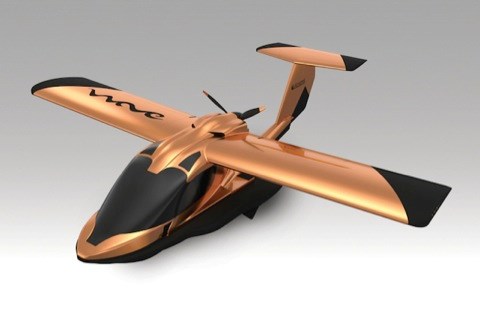A surge in seaplanes?
The current bright spot in general aviation might be in light-sport aircraft (LSA), and more specifically in seaplanes.
Share

The Vickers Wave seaplane is a true composite, built from an aluminum primary structure surrounded by a carbon fiber hull.
The current bright spot in general aviation, according to a March 30 online article by Dan Johnson of General Aviation News, is light-sport aircraft (LSAs, see the original article here: generalaviationnews.com/2014/03/30/seaplane-lsas-take-off/). Johnson says that as LSAs approach the end of their first decade this summer, 134 models have already been created and gained FAA acceptance, an impressive pace that represents more than one new design every month for 10 years running.
In 10 years, LSA have morphed from ultralight or light kit aircraft into a fleet of modern and capable aircraft manufactured under industry consensus standards. In 2014 it is becoming clear that the LSA industry is embarking on a new level of achievement; some of the most intriguing of these, says Johnson, are seaplanes.
Icon stimulated the market for these advanced ships with fresh ideas and creative engineering. A team from Scaled Composites (key participants in the creation of SpaceShipOne and many unique aircraft) joined Icon to produce the A5. The Southern California company reportedly has more than 1,000 aircraft orders. While Team Icon works to assemble a manufacturing system, other seaplane designs are coming into view. In addition to several proven designs, including Searey, Super Petrel, SeaMax and Mermaid that are all presently accepted by FAA as Special LSAs (SLSA), Freedom, Aventura, and Atol are also in the mix (a review of most of these can be found at www.bydanjohnson.com/Sidebar.cfm?Article_ID=1732).
Yet among LSA seaplanes, the next generation wave is building and Johnson expects additional designs to emerge this year. Among them are some of the most technically sophisticated flying machines in the entire LSA space.
Consider this: The Lisa Akoya, Icon’s A5, the Vickers Wave, and one other unidentified company have all secured substantial funding from Chinese investors. They join such notable aviation enterprises as Cirrus Aircraft, Continental Motors, Flight Design, Superior Air Parts and others in securing Chinese investment. In the case of the LSA seaplanes, the investors are not taking over the companies and appear primarily focused on the China market, says Johnson.
Lisa’s Akoya, priced near $400,000, is a unique design that in some ways attempts to surpass Icon’s A5. Both are flying at present, but neither has gone to the conforming prototype stage, according to Johnson (see the CompositesWorld blog about Lisa Airplanes dated 1/31/14).
The groundbreaking Wave from Vickers Aircraft in New Zealand has reportedly received funding from Chinese investors, which could accelerate its seven-year-old design project so that it can take to the skies this summer.
Wave (pictured) has several popular characteristics, such as powered folding wings, sliding doors, enough aft cabin space to allow a four-seat design in the future, and specialized landing gear involving as many as seven wheels. Wave’s “Cross-Over” landing gear does not need to be retracted, which eliminates some weight and reduces pilot workload. The gear pivots enough to aid crosswind landings on hard surfaces.
Wave is a true composite, built from an aluminum primary structure surrounded by a carbon fiber hull. As parts go together in prototype number one, Vickers said all parts are matching the weights as predicted by state-of-the-art computer design software.
As with every design since the Wright brothers’ first biplane 111 years ago, the proof of design will be found in the flying, but Wave, A5, Akoya, and others yet to be identified are showing the LSA seaplane subcategory to be a fountain of engineering prowess.
See the original article here: generalaviationnews.com/2014/03/30/seaplane-lsas-take-off/
Related Content
Cryo-compressed hydrogen, the best solution for storage and refueling stations?
Cryomotive’s CRYOGAS solution claims the highest storage density, lowest refueling cost and widest operating range without H2 losses while using one-fifth the carbon fiber required in compressed gas tanks.
Read MoreManufacturing the MFFD thermoplastic composite fuselage
Demonstrator’s upper, lower shells and assembly prove materials and new processes for lighter, cheaper and more sustainable high-rate future aircraft.
Read MorePlant tour: Middle River Aerostructure Systems, Baltimore, Md., U.S.
The historic Martin Aircraft factory is advancing digitized automation for more sustainable production of composite aerostructures.
Read MoreCombining multifunctional thermoplastic composites, additive manufacturing for next-gen airframe structures
The DOMMINIO project combines AFP with 3D printed gyroid cores, embedded SHM sensors and smart materials for induction-driven disassembly of parts at end of life.
Read MoreRead Next
VIDEO: High-volume processing for fiberglass components
Cannon Ergos, a company specializing in high-ton presses and equipment for composites fabrication and plastics processing, displayed automotive and industrial components at CAMX 2024.
Read MoreAll-recycled, needle-punched nonwoven CFRP slashes carbon footprint of Formula 2 seat
Dallara and Tenowo collaborate to produce a race-ready Formula 2 seat using recycled carbon fiber, reducing CO2 emissions by 97.5% compared to virgin materials.
Read MorePlant tour: Daher Shap’in TechCenter and composites production plant, Saint-Aignan-de-Grandlieu, France
Co-located R&D and production advance OOA thermosets, thermoplastics, welding, recycling and digital technologies for faster processing and certification of lighter, more sustainable composites.
Read More






















